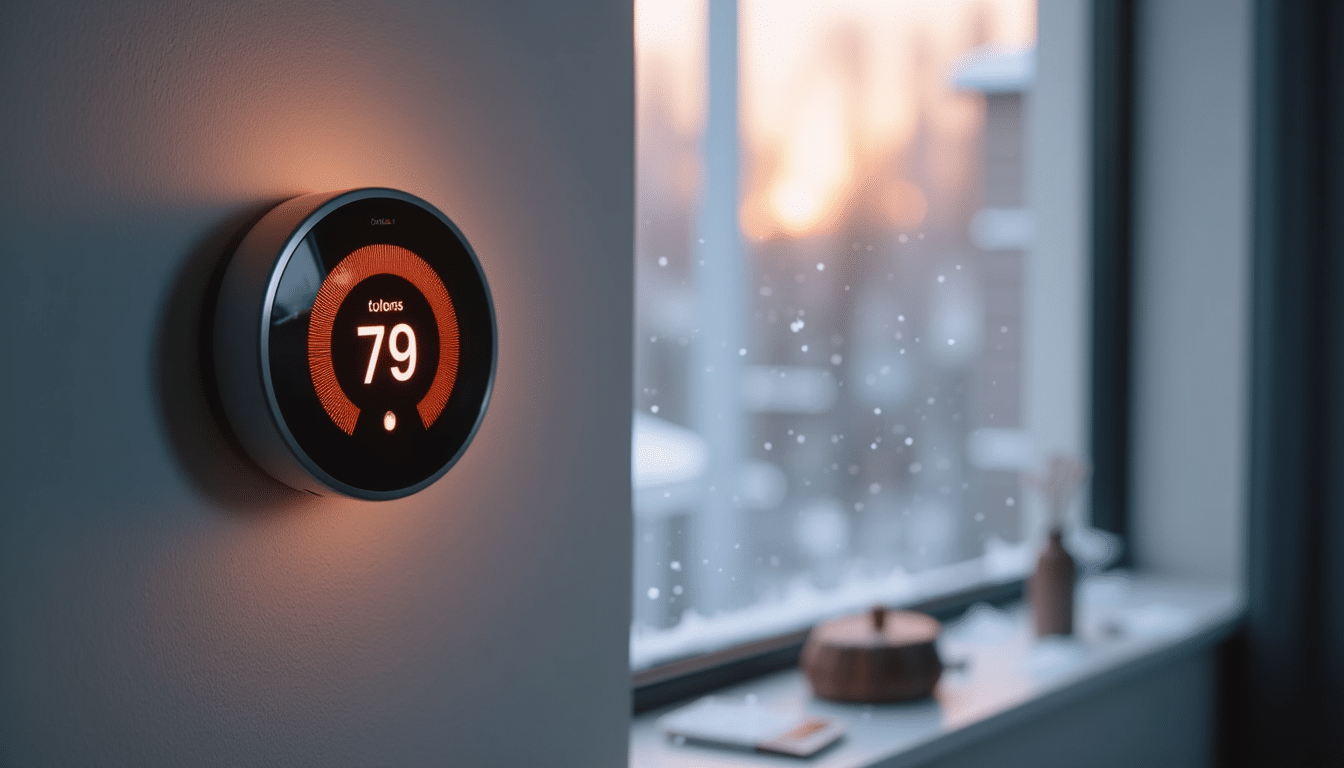What Makes a Smart Thermostat ‘Smart’?
Before we dive into the list, let’s quickly cover what sets these devices apart from regular programmable thermostats:
- Remote control: Adjust your heating from anywhere via smartphone apps
- Learning capabilities: They study your routines and adjust automatically
- Weather adaptation: Many use local forecasts to optimise heating
- Energy reports: See exactly how much you’re using and saving
- Smart home integration: Control via voice with Alexa, Google Home, or Apple HomeKit
The 10 Best Smart Thermostats for UK Homes in 2025
1. Google Nest Learning Thermostat (4th Generation)
Price: £199-£249
The Nest remains the gold standard for smart thermostats in 2025. The fourth generation builds on what made earlier models great while adding some genuinely useful new features.
What I love: It learns your preferences within about a week, creating a schedule that works around your life. The display turns blue when cooling and orange when heating – a small touch that just makes sense. The latest model now includes room sensors that detect occupancy, so it won’t waste energy heating empty rooms.
Worth noting: While it works with most systems, some UK combi boilers require a professional installation. The price tag is steep, but the energy savings typically pay for it within two years.
2. Hive Active Heating 3
Price: £179 (plus installation)
Developed specifically for British homes, Hive continues to be one of the most reliable systems for UK heating setups.
What I love: The geolocation feature is brilliant – it can automatically turn your heating down when you leave home and back up when you’re returning. The latest version includes improved zoning capabilities, allowing different temperatures in different areas if you add the right accessories.
Worth noting: While the app is much improved, it occasionally takes a moment to connect. Installation by a British Gas engineer is recommended but adds to the cost.

3. Tado Smart Thermostat V4
Price: £199.99 (starter kit)
Tado’s reputation for energy efficiency keeps growing, and their fourth-generation model offers impressive savings for UK homes.
What I love: Its open window detection is the best I’ve tested – it automatically turns off heating when it detects a draft, saving energy without any input from you. The Clean Energy Integration feature, new for 2025, helps you use energy when renewable sources are most abundant.
Worth noting: To get the most from Tado, you’ll want their Smart Radiator Thermostats too (around £70 each), which adds to the cost. Their subscription model for advanced features isn’t everyone’s cup of tea.

4. Drayton Wiser
Price: £129.99 (starter kit)
This British-designed system offers exceptional value for money without compromising on features.
What I love: Setting up room-by-room heating control is simpler and more affordable than with most competitors. The heat report function helps you identify which rooms use the most energy. It’s particularly good for UK combi boilers.
Worth noting: The app interface isn’t as polished as Nest or Hive, but it’s improved significantly with recent updates.
5. Honeywell Home Evohome
Price: £249.99 (base unit)
For larger homes with complex heating needs, Evohome remains the most comprehensive solution.
What I love: True zoned heating without rewiring your entire system. You can control up to 12 zones independently, perfect for larger UK homes. The 2025 model features enhanced AI that predicts how long it takes to heat specific rooms in your home.
Worth noting: The initial investment can be significant once you add radiator controllers (around £60 each), but it offers the most precise control of any system I’ve tested.
6. Netatmo Smart Thermostat
Price: £149.99
This stylish thermostat designed by Philippe Starck offers a great balance of aesthetics and functionality.
What I love: The energy-saving reports are detailed and actionable. Its Auto-Adapt feature accounts for your home’s insulation and outdoor temperature to start heating at the right moment. It’s also one of the easiest to install yourself if you’re reasonably handy.
Worth noting: The display is minimalist – perhaps too minimalist for some users who prefer more information at a glance.
7. Salus IT500
Price: £99.99
The budget-friendly option that doesn’t feel budget at all.
What I love: Straightforward installation and operation make this perfect for smart heating beginners. The latest model now works with Amazon Alexa and Google Assistant, addressing a previous limitation.
Worth noting: It lacks some advanced features like learning capabilities, but handles the basics excellently.

8. Ecobee Smart Thermostat Premium
Price: £229.99
Recently expanded to the UK market, Ecobee brings some unique features that set it apart.
What I love: The built-in air quality monitor adds genuine value, alerting you when your home’s air needs attention. The voice control works without a separate smart speaker, and the built-in Siri and Alexa functionality is seamless.
Worth noting: As a newer entrant to the UK market, some users report occasional compatibility issues with certain British heating systems.
9. Warmup 4iE
Price: £189.99
Specifically designed for homes with underfloor heating, this specialist thermostat excels in its niche.
What I love: The SmartGeo technology tracks your location and adjusts your floor heating accordingly, ensuring warm floors when you arrive home. The energy monitoring is exceptionally detailed.
Worth noting: It’s overkill if you don’t have underfloor heating, but unbeatable if you do.
10. Energenie MiHome Heating
Price: £99.99
A budget-friendly British option that punches above its weight.
What I love: Impressive compatibility with UK boiler systems at a fraction of the price of premium options. The open-source nature means new features are constantly being developed by the community.
Worth noting: The app is functional but not as polished as premium competitors. Perfect for the technically inclined who enjoy tinkering.

Key Features to Consider When Choosing Your Smart Thermostat
When shopping for a smart thermostat for your UK home, keep these factors in mind:
Compatibility
Check if the thermostat works with your specific heating system. UK homes often have combi boilers or systems without a neutral wire, which can limit your options. Most manufacturers have compatibility checkers on their websites.
Installation Requirements
Some systems are DIY-friendly, while others require professional installation. According to Energy Saving Trust, proper installation is crucial for both safety and efficiency.
Smart Home Ecosystem
If you already use Google Home, Amazon Alexa, or Apple HomeKit, choosing a compatible thermostat will make life easier. For more on creating a cohesive smart home, check out our guide on building a connected home.
Learning Capabilities
Thermostats that learn your schedule can save more energy than basic programmable models. The best ones adjust automatically to changes in your routine.
Energy Monitoring
Detailed usage reports help you understand your consumption patterns and identify savings opportunities.
Are Smart Thermostats Worth the Investment?
The short answer is yes – for most UK homes. Research by British Gas suggests the average household can save between 10-25% on heating costs with a smart thermostat.
For a typical semi-detached house in North Yorkshire paying around £1,200 annually for heating, that’s a potential saving of £120-£300 per year. Even with the pricier models, you could recoup your investment within 1-2 years.
Beyond the financial benefits, there’s the convenience factor. Adjusting your heating while commuting home on a chilly evening or warming up the house remotely before returning from holiday is genuinely life-enhancing.
My Personal Take
After testing smart thermostats for nearly a decade, I’ve had Nest, Hive, and Tado systems in my own homes. Currently, I use the Tado system with radiator thermostats throughout my North Yorkshire terrace.
What I’ve learned is that the ‘best’ system often depends on your specific needs. If you want set-it-and-forget-it simplicity, Nest is brilliant. For a larger home where different rooms need different temperatures, Evohome or Tado with radiator valves makes more sense.
The technology that’s impressed me most in 2025’s models is the improved AI that predicts how your home heats up and cools down. My current system starts heating precisely when needed to reach my desired temperature exactly on schedule – not before (wasting energy) or after (leaving me cold).
Bonus Tip: Get the Most from Your Smart Thermostat
Whatever system you choose, take time to use the energy reports they generate. I check mine monthly and have discovered surprising insights – like how much heat was being wasted in my rarely-used spare room before I added a smart radiator valve.
Also, don’t overlook integration with other smart devices. I’ve linked my thermostat to my smart doorbell so the heating automatically reduces when the door is left open for deliveries – a small thing that adds up over time.
For more ways to make your home more energy-efficient, check out our guide on smart energy solutions for UK homes.
Have you taken the plunge with a smart thermostat yet? I’d love to hear which system you chose and how it’s working for you in the comments below!







